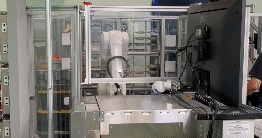
There are two cooks, a hypeman, and a robot at Kernel on Park Avenue South, a new fast-casual restaurant that has been designed to automate everyone’s lunch. Kernel, which is also vegan, operates on a theory of double do-gooding: Eliminating meat and dairy is good for the planet, while eliminating labor is good for investors and the bottom line.
These are worthy aims, though also arguable: Meat production is indisputably a major pollutant, but eating plant-based is not by default “better” for anyone, and optimizing as many humans as possible out of the production process is not an unalloyed good, as an union steward can tell you. Optimizing returns is often thought to be good, especially for people who are personally invested in a company, as Kernel’s Steve Ells is, to the tune of $10 million, which helped lure in an additional $36 million in Series A funding, as did Ells’s very relevant backstory: He founded, and for years successfully ran, Chipotle.
None of this, however, answers the more elemental question: Is Kernel good?
On a recent Thursday afternoon, I went to find out. Early reviews had been strong enough — ”It’s not just good for a veggie burger, it’s a good burger, period,” reported Bon App a couple months ago — and I was curious where the company stands relative to the Digs and Sweetgreens of the world. The biggest difference between Kernel and these build-your-own-bowl competitors — plus Naya, and Cava, and Chop’t, and, really, much of the fast-casual of the post-Chipotle landscape — is the absence of “build-your-own.” Kernel doesn’t customize. Kernel offers; customers accept. The model reminded me more of “traditional” fast food.
Kernel’s first and currently only location has the high-gloss of a friendly tech utopia. The whole room is ispainted the color of the cream in an Andes mint, a seafoam I suspect is being beta-tested to succeed Glossier pink in the American subconscious, while a bouncy, piped-in soundtrack was blessing the rains down in Africa. The store is set up with walls of numbered cubbies surrounding a central prep station, where two cooks and a robot arm prep dishes beneath flat screen monitors and an ominous digital countdown clock. There are no cash registers, and very little human interaction, though the hypeman — actually a hype-woman — was on hand to direct me to pull up Kernel’s website on my phone; all orders are placed by phone or app. There are also no seats: Two long counters run along the walls, but Kernel is meant to be taken to go.
None of this does much to dispel the nagging feeling that there’s no there there, though it is fun to watch the jerky robot arm lift your little dish from a rolling rack of trays and feed it into the impingement oven, where it’s blasted with heat and circulating air currents (in other words: a souped-up air fryer). Two human cooks prep and garnish.
And the food? The menu is divided between fast-food-y sandwiches and cheffier sides. (Ells, who many lifetimes ago was a sous chef for Jeremiah Tower, brought in Andrew Black and Neil Stetz, two chefs of Michelin-starred experience, to oversee the menu.) Between a fried “chicken” sandwich and a quinoa-heavy veggie burger, I preferred the chicken: It managed a good fry-crisp, seitan-y flavor, and a decent chew, and was punchily dressed with chipotle vegannaise and a brace of pickles. I found the burger to be more standard-, dressed up with pickled onions and a “salsa verde” that tasted mostly of avocado “mayo.”
Streamlining operations at scale requires some modularity, and once I started noticing that the sauces on the sandwiches have a way of turning up in the sides and on the side, a little of the magic was dispelled. The salsa verde reappeared in a side of roasted carrot nuggets with farro and dates; either sauce was available with Kernel’s answer to fries, “thrice-fried” potato cubes, which come smartly packaged under a perforated cardboard lid to maintain their crisp.
I didn’t have any problem finishing my lunch, though I did wonder how good I should feel afterwards. My wallet felt fine; Kernel’s prices are higher than its mega-sized fast food competitors — Kernel’s chicken sandwich is $9; KFC’s spicy chicken sandwich, $5.49 — but anyone accustomed to $15 burrito bowls won’t sweat it too much.
My blood pressure, on the other hand, could’ve borne it better. The overwhelming flavor of much of what I ate was salt, followed by vinegar. Anyone accustomed to vegetarian substitutes is used to those being freely deployed, of course. But when I sought out nutritional info from Kernel brass (the company says it will soon be available online), the reality was intense: Kernel’s chicken sandwich contains 2,780 mg of sodium, well over the FDA’s recommended daily maximum of 2,300 mg. That in itself is not shocking (the average American eats 3,400 mg), yet even among fast food, that’s high. KFC’s spicy chicken sandwich has 2,140 mg; McDonald’s Spicy McCrispy™ clocks in at 1,320.
Vegan junk food is still junk food, alas. But what the hell. Only robots live forever.
Related
- The Fast-Food Obsessive Who’s Still Trying to Solve Lunch
Matthew Schneier , 2024-05-21 17:20:00
Source link


